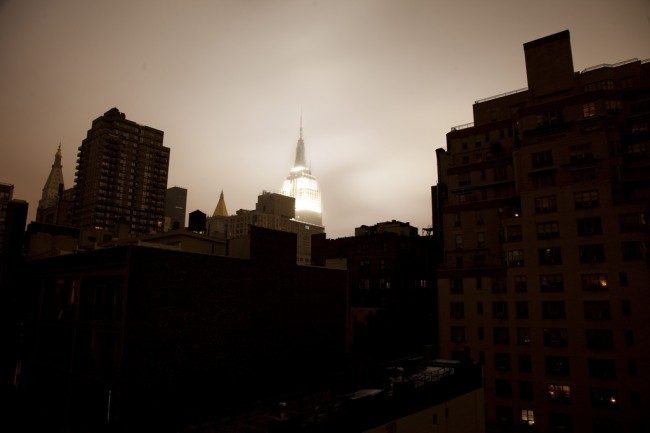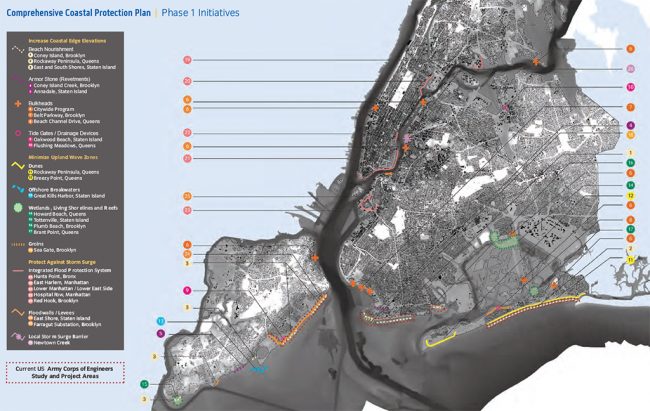
We are celebrating 15 years — and counting — of stories that are deeply researched and deeply felt, that build a historical record of what the city has been.
We are celebrating 15 years — and counting — of stories that are deeply researched and deeply felt, that build a historical record of what the city has been.

The Empire State Building lights up the sky over a powerless lower Manhattan | Photo via Christopher Schoenbohm
A year after Superstorm Sandy’s arrival, the city and the region are remembering the impact of the storm, taking stock of what the interim has brought, and considering how to prepare for the future. The Atlantic and The Huffington Post have put together before and after images of the storm, showing a dark, quiet, and damaged city few had seen before and how far many of the most devastated places have come since. The Museum of the City of New York this week opened Rising Waters: Photographs of Sandy, a juried exhibition of works submitted to an open call to professional and amateur photographers with imagery illustrating life and landscape before, during, and after. And with powerful images come equally powerful stories. WNYC has compiled “Life after Sandy: Minute by Minute” (below), stories from New York and New Jersey residents on how their lives have been transformed a year out from the landfall, as part of their broader Life After Sandy series. And the Times visits neighborhoods and residents still coping with the aftermath of the storm for their feature “Hurricane Sandy: A Year Later.” Below, we take a look at where transit, buildings, and the broader rebuilding process stand one year later.
Getting Around
Just four days after Sandy’s storm surge crippled regional transit networks, the MTA began restoring service to New York’s subway system. Though the reinstatement was an impressive feat, The New York Times Magazine asks whether the system can withstand another hit, noting the need for technological improvements and the preservation of knowledge embedded in the MTA’s long-time engineers and carpenters. While vintage technologies performed far better than expected, newer systems failed and often only the know-how of experienced employees allowed the system to bounce back as quickly as it did.
To get the system back online and the city moving again as quickly as possible, repairs were often temporary solutions, resulting in lingering delays, closures, and maintenance work that may hamper the system for years to come. But coping with these challenges has also produced some positive developments: new transit methods like the Rockaway Ferry were put into service, which might stick around even after the storm’s effects have passed.
Buildings
A large proportion of New York City Housing Authority (NYCHA) properties are located in particularly vulnerable areas of the city, and public housing residents were among the most affected. Many repairs, both symptoms of years of deferred maintenance and Sandy’s damage, have yet to be completed, and temporary heating and hot water boilers remain in place with no clear timeline for more permanent fixes.
Acknowledging that existing building codes created vulnerable housing stock in the face of storms like Sandy, new codes and requirements have since been implemented with the goal of building back safer. But delineating such new regulations takes time. In the chaos of insurance and unclear standards following the storm, most property owners want and need to rebuild as quickly as possible, and often can’t afford the added expense or do not take note of new regulations. Many are rebuilding in the same place and in the same way as before, leaving themselves just as vulnerable to the next storm. In the meantime, flood insurance premiums are rising and many insurers are pulling out of high-risk areas.
And while many Sandy victims simply want to get back to some sense of normality, others are preserving and remembering their experience by marking waterlines, badges of honor and remembrance for what the storm brought and everything that they have been through since.

Phase 1 Initiatives of the Comprehensive Coastal Protection Plan — Resiliency Plan | Courtesy of the Special Initiative for Rebuilding and Resiliency
Rebuilding
A broad conversation on rebuilding began almost as soon as the storm clouds dissipated, but large questions about how to protect the region from future storms remain. After months of study, the City’s Special Initiative for Rebuilding and Resiliency (SIRR) released “A Stronger, More Resilient New York,” a plan for rebuilding and increasing the resilience of infrastructure and buildings citywide. Of the 257 recommendations identified and outlined, only 20 have been implemented to date. Natural interventions, including the restoration of marshes, oyster beds, and other environmental elements, as green infrastructure to protect the city increasingly enter into the conversation. The scale at which they can be implemented and their effectiveness, however, remain to be seen.
The resiliency of cities has occupied the attention of the design, building, and planning communities since the storm. One initiative that is mobilizing this thinking is the federal Department of Housing and Urban Development’s Rebuild By Design competition, a three-month research and analysis process to identify key design opportunities to make the region more resilient. Ten multidisciplinary teams displayed 3-5 ideas in a public forum on Monday, examining new infrastructure — built, social, and environmental — that can foster improved resiliency. Each team will focus on one opportunity to continue to develop with the intention of future implementation. For more on the competition, check out our interview with Eric Klinenberg.
As this anniversary of Sandy passes, we must look ahead to what lands on our shores next as much as we remember the storm that came. In the weeks and months to come, we will continue to look at the strategies for strengthening and preparing our city and check in on the progress we’re making, as we have over the past year. Look back at our coverage of Sandy’s aftermath here and visit The Architectural League website for a compilation of text and video from the League and UO on “Meeting the Demands of New York’s New Realities.”
The views expressed here are those of the authors only and do not reflect the position of The Architectural League of New York.